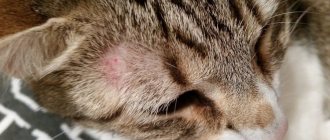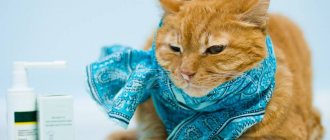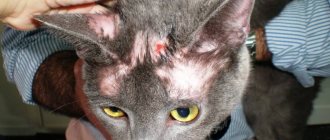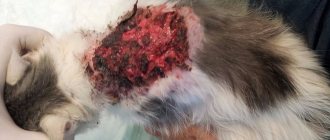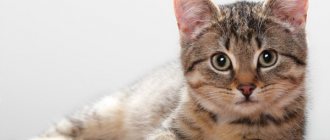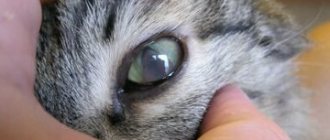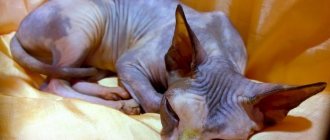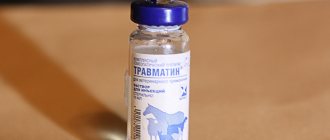Mastitis in a nursing cat poses a mortal danger not only for the sick cat, but also for the kittens. Owners engaged in breeding often encounter this problem. But pregnancy and lactation are not always the cause of mastitis - in rare cases, the disease affects untied and sterilized pets. Knowledge of the main symptoms will help to detect the disease at an early stage and begin its treatment in a timely manner.
What does mastitis look like in cats?
It is not difficult to notice alarming symptoms, but only a veterinarian can correlate them with a specific form of the disease. Because of this, doctors prohibit treating mastitis in cats at home until diagnosis. In some forms, this will not only have no effect, but will also worsen the pet’s condition.
What it is
The main sign of mastitis in cats is clearly visible in the photo. During the inflammatory process, milk bags swell to unnatural sizes. Pathology can cover only one or several milk bags (paired areas). The most common causes of the disease are infections of bacterial etiology.
Lactation and non-lactation mastitis
The lactational appearance occurs due to lactostasis, that is, stagnation of breast milk. Untimely and insufficient emptying of bags leads to the growth of pathogenic microflora. The growth of bacteria promotes the fermentation process that curdles the milk. Due to stagnation, the walls of the epithelium are damaged, increasingly impeding the natural outflow of fluid. The bacteria continue to multiply, infecting the lymph nodes and veins through the thinned epithelial walls.
The non-lactation type is less common. It develops in immunodeficiencies due to injury to milk bags or pustular skin diseases. This type of pathology is not associated with the formation of mother's milk, does not depend on age and has a milder course.
Causes and risk factors
Mastitis in a nulliparous cat is a rare occurrence. In such cases, the disease is explained by weak immunity. When a pathogen invades, the amount of antibodies produced by immune cells is insufficient.
Why mastitis may develop
Weakened immunity can be congenital or acquired. In the second case, the root cause is prolonged helminthiases, chronic diseases, poor feeding and maintenance in unfavorable conditions. The inflammatory process is also provoked by:
- diseases of the genital organs;
- difficult childbirth;
- false pregnancy and other hormonal imbalances;
- lactostasis;
- mechanical damage to the nipples;
- postoperative complications;
- taking hormonal contraceptives;
- hyperthermia, which is an increased danger for hairless breeds.
Pathology is often inherited. When buying a kitten, do not forget to check about the diseases of its parents.
In a sterilized cat
The risk of pathology is high in animals that have undergone incomplete sterilization with removal of the uterus. The remaining ovaries continue to produce hormones. This is fraught with hormonal imbalances and false pregnancy.
Another reason is postoperative complications associated with suture infection. The infection quickly spreads to milk bags, worsening the animal's condition.
In a female after childbirth and during feeding
Mastitis in a cat after childbirth is associated with postpartum complications (pyometra, endometritis) and lactostasis. Problems with breastfeeding appear when kittens are early weaned from their mother, have a small litter, or have a mass death.
During lactation, inflammation can occur due to mechanical injuries. When feeding, kittens often damage their mother's nipples with their claws or teeth. Appearing cracks are open “gates” for pathogenic infections. The reason may also lie in selective feeding. Kittens can ignore part of the nipples, causing stagnation of milk in them.
Disease prevention
In order to protect your animal from illness, a number of rules should be followed:
- eliminate rapid flow of milk;
- control the pet’s feeding schedule;
- Regularly clean the cat and kittens’ resting place, wash the bed and other accessories, and ensure high-quality hygiene;
- do not allow the feline to be in the cold and drafts;
- constantly examine the female during the period of feeding kittens, pay attention to stagnation of milk in the cat, external damage, neoplasms, discharge and other suspicious signs;
- care for your pet’s nipples during pregnancy and after birth;
- wipe the mammary glands with a weak solution of potassium permanganate when even the smallest scratches appear;
- sterilize your cat only in trusted veterinary clinics;
- prevent contact of a nursing cat with sick animals;
- follow the schedule of vaccinations, treatment against skin parasites and helminths (step-by-step instructions are given by the veterinarian during a routine examination).
Mastitis in a nursing cat can be completely cured without any complications. The owner must carefully monitor the animal in order to notice pathological changes in time. It is important to keep your pet in suitable conditions, provide it with warmth and hygienic care.
Video
Symptoms by form of manifestation
After detecting signs and symptoms, treatment of mastitis in a cat at home is possible only for serous and catarrhal forms. In other cases, hospitalization and surgical assistance from a surgeon may be necessary.
For serous
Serous mastitis in a cat leads to swelling of the bags and an increase in local temperature in the area of the seals. Watery yellow milk with a flaky structure appears from the nipples. Pain on palpation and hyperthermia are rare. If there are no unpleasant sensations, the animal does not interfere with the inspection.
With fibrinous
The fibrinous form is always painful. The sick pet has a fever. Lymph nodes on milk cartons are swollen. When you press on the affected lobes, a crunching sound is heard.
With phlegmonous
Occurs as a complication of the purulent form. Inflammation spreads to all breast tissue. In an advanced situation, sepsis begins, threatening the death of the animal.
For catarrhal
The catarrhal form affects glandular tissue. Due to lactostasis, milk sours and thickens, blocking the holes in the nipples. Nodules form inside the gland, disappearing after pumping or feeding. The disease is painless or with moderate pain. Fever is rare.
For hemorrhagic
Occurs as a complication of serous and catarrhal forms. Accompanied by intense redness of milk bags or the appearance of spots formed due to excessive hemorrhage (bleeding). The condition is complicated by severe fever and pain.
For gangrenous
Appears in advanced cases of necrosis. Affected tissues turn blue or acquire a dark brown tint. As a result of necrotic processes, ulcerative bleeding occurs.
With purulent
Purulent mastitis in a cat is accompanied by the release of cloudy fluid. It contains patches of pus and smells unpleasant. The animal's milk supply decreases, lethargy and fever appear. The pet experiences acute pain, constantly meows and prevents any attempts at palpation. The affected areas swell and become intensely red. In advanced cases, the ability to lactation is completely lost. The pathology often develops into chronic.
With abscess
Another variant of an advanced purulent form. Purulent capsules form inside the glands. When they rupture, the contents quickly spread throughout the body. Without timely treatment, the animal dies from blood poisoning.
With stagnation
It assumes stagnation of milk without the formation of purulent lesions and other dangerous complications. It includes serous and catarrhal forms of the disease.
Expressing milk
Expressing milk can only be done in the absence of purulent abscesses and foci of necrosis. Do not try to express fluid by applying strong pressure to the nipples. The most convenient way to carry out the procedure is with a breast pump, which can be made from a syringe with a rubber piston. The top of the syringe is removed along with the nozzle on which the needle is placed. After this, the cut edge is melted and rounded.
The circle is smoothed out with your fingers. Then the free edge of the syringe is applied to the nipple and a vacuum is created by pulling the piston. This leads to a gentle release of milk from the gland. If liquid does not appear, you should not increase the pressure, because The problem may be a blocked duct. In this case, pumping cannot be performed.
Possible complications and consequences
If your cat shows signs of mastitis, check with your veterinarian about what to do to prevent complications. Diagnostics is needed even in congestive forms, since all drugs are selected individually.
Late visit to a veterinary clinic and self-medication are fraught with:
- proliferation of inflammation;
- damage to the heart and brain;
- development of sepsis;
- infectious-toxic and painful shock;
- the appearance of malignant neoplasms.
Any of these conditions can lead to the death of the animal. To prevent these complications, be persistent and regularly examine the chest and abdomen of your pet who has given birth.
Diagnostic methods
Self-diagnosis is excluded, since to determine the disease it is necessary to check the milk for the presence of a pathogenic environment. This research method is only possible in a veterinary clinic.
The symptoms of the pathology are similar to adenomas, mastopathy and mammary hyperplasia. To exclude them, the veterinarian collects anamnesis, examines the furry patient and conducts the following studies:
- a blood test showing an increase in white blood cells and a decrease in platelets;
- PCR diagnostics of milk and exudate, identifying the pathogen;
- cytology, which reveals the exact form of the disease;
- Ultrasound, which determines the progress of the process.
Additionally, antibiotic resistance is checked - the sensitivity of pathogens to antibacterial drugs. Further therapy depends on the results obtained.
Mastopathy
Chronic mastitis can cause mastopathy.
It is generally accepted that the main cause of mastopathy is hormonal disorders. However, this pathology can occur as a complication of chronic mastitis.
Clinical signs
The main symptoms are associated with enlarged mammary glands.
- The provoking cause, the factor of which is a stagnant process, is characterized by fibroepithelial hyperplasia of a diffuse form .
- The entire area increases in size with the presence of multiple compactions, and not only individual compactions are painful, but also the entire inflamed area.
- If ulcers begin to appear, help will be very difficult and the effectiveness of the prescribed treatment will remain in question.
Drug therapy and medical procedures
In most cases, treatment is carried out at home. The animal is given massages, the affected glands are bandaged and treated with external means.
In advanced cases, in addition to drug therapy, surgical intervention is performed. The operation to remove purulent contents and necrotic tissue is performed under general anesthesia.
Priority actions
Before visiting a veterinary clinic, first aid is allowed. To do this you will need:
- Reduce the amount of liquid consumed. If you drink a small amount, milk production will slow down. It is also recommended to temporarily eliminate wet food in favor of dry food.
- Express milk. Do this yourself or with the help of the kittens, offering them milk from all nipples.
If there are cracks or foreign impurities appear, feeding the litter and expressing it yourself is unacceptable. Heating the inflamed lobes is no less dangerous - high temperatures and humidity are ideal for the growth of pathogenic microflora.
Medicines and injections
After the diagnosis is made, the animal is given injections that relieve inflammation (Mastometrin, Calcium gluconate, Travmatin) and given immunomodulators (Katozal, Gamavit). For severe swelling, diuretics are prescribed.
Advanced mastitis in a cat with severe pain is treated with novocaine blockade using antibacterial (Cefazolin, Sinulox, Ampicillin) or antifungal drugs (Amphotericin, Griseofulvin). The duration of antibiotic treatment depends on the type of disease and ranges from 5 days to 1 month.
Severe tissue damage and extensive abscess will require surgery. The affected gland is partially cut out or completely removed.
Folk remedies
Treatment of mastitis in cats with folk remedies is permissible only under the supervision of a veterinarian. To relieve inflammation, use fresh cabbage leaves, mashed with a rolling pin until juice appears. Other common lotions include oak bark decoction, chamomile and sage infusions. Sage is also used internally to reduce lactation. It is recommended to check with your doctor for exact dosages.
The resulting decoctions and infusions are cooled to room temperature. Bandages or gauze dressings are soaked in them, squeezed out and applied to the inflamed glands. The procedures are carried out 3 times a day until the symptoms disappear completely.
Massage
The massage technique involves gently “scratching” the gland 2-3 times a day. Move smoothly from the base of the bag to the nipple for 5 minutes. For better effect, add camphor oil, which has antiseptic and analgesic properties. Such massage is allowed only for mild forms of the disease, excluding the presence of pus and tissue necrosis.
Animal care
During therapy, remove the water after each feeding. Isolate kittens from your pet and tape or bandage their nipples to prevent any attempt at feeding. A blanket or collar is useful for additional protection.
Use prescribed medications strictly according to the regimen recommended by your doctor. If the condition improves, do not stop taking the medication without your veterinarian's approval. After surgery, lubricate the wounds with Levomekol and keep the dressings clean. If there is pus or blood, treat the glands daily with Chlorhexidine or hydrogen peroxide.
How to help your cat at home?
If it is impossible to see a doctor, you can treat the lesion with traditional methods of treatment, which have been used since ancient times. These include the following approaches:
- complete isolation of kittens from the cat and provision of appropriate care for them;
- application of lotions and compresses with anti-inflammatory herbs;
- daily sanitary cleaning using safe antiseptics of the animal’s habitat.
You can read below about how to apply lotions with an anti-inflammatory effect.
Making lotions for cats with mastitis
Related Issues
Most of the questions that arise for the owner of a sick animal concern the safety of self-treatment. Particular concern occurs during pregnancy or after a recent birth, when kittens have to be separated from their mother.
Is it possible to carry out self-treatment?
Yes, but only with serous or catarrhal form confirmed by a veterinarian. Attempts at self-diagnosis are unacceptable, since the slightest mistake will lead to the death of the animal.
What to do with kittens while their mother is being treated?
The presence of impurities in milk can lead to acute poisoning with a fatal outcome. In case of purulent forms and inflammation of all glands, kittens are isolated. Until the mother recovers, they will have to be fed artificial milk formula. In the absence of suppuration and damage to several glands, feeding is acceptable. In this case, the damaged lobes are bandaged, and the kittens are given access to healthy nipples.
How to treat a pregnant cat?
When treating pregnant animals, topical preparations and folk remedies are used. Before the litter appears, timely expression of milk is recommended. Antibiotics and surgery are used only in advanced cases, as they can be detrimental to unborn babies.
What to do
The first thing to do is to carefully examine the nipple yourself. To understand the nature of the disease, whether there is a tumor under the nipple and to see the cat’s reaction.
The next step is to take your pet to a doctor for examination . Only a specialist can accurately determine the cause of the tumor and decide what needs to be done. It may be necessary to remove breast tumors surgically if the cancer is in its early stages. Or, if it is mastitis, and the tumor is the remains of milk. You will need to take a course of antibiotics. In any case, both diagnosis and treatment are prescribed only by a veterinarian
